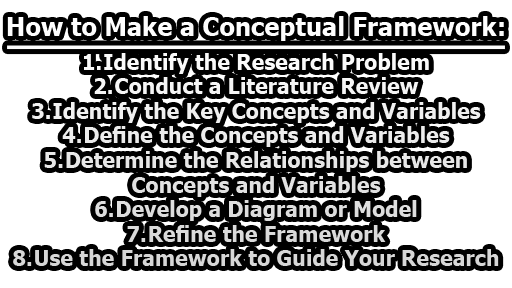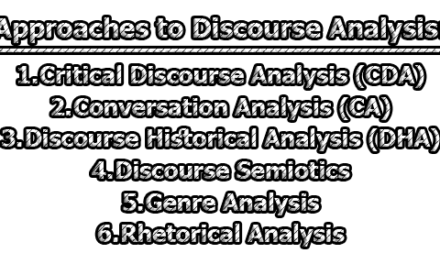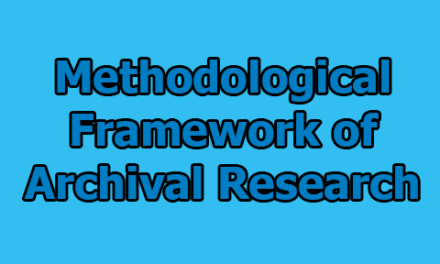A conceptual framework is a structured approach to organizing ideas, theories, and concepts to better understand a particular phenomenon or problem. It is a way of visualizing the relationships between different variables or factors that affect a specific area of study or research. Conceptual frameworks provide a set of assumptions, concepts, and ideas that help to explain or predict a phenomenon. They typically consist of a set of interconnected concepts or variables, their definitions, and the relationships between them. They help researchers to define the scope of their study, identify gaps in existing knowledge, and to develop hypotheses that can be tested through research. Conceptual frameworks are used in a variety of fields, including social sciences, natural sciences, engineering, and business. They are often depicted as diagrams or models that illustrate the relationships between different concepts or variables, and they are typically used to guide research, decision-making, and problem-solving. In the article, we are going to know how to make a conceptual framework.
Definitions of Conceptual Framework:
According to Miles and Huberman (1994), a conceptual framework is “a set of interconnected ideas, concepts, and assumptions that provide a way of understanding and explaining a phenomenon.” They note that a conceptual framework helps researchers to identify key variables, to develop hypotheses, and to guide data collection and analysis.
Babbie (2016) defines a conceptual framework as “a logical structure of related variables and assumptions that guides the researcher’s interpretation of data and findings.” He notes that a conceptual framework should be grounded in existing theory and research and that it should be used to guide the research process from start to finish.
In the field of nursing, Walker and Avant (2011) define a conceptual framework as “a set of concepts and relationships among those concepts that describe and explain a phenomenon.” They note that a conceptual framework helps to provide a systematic and organized approach to understanding a phenomenon and that it can be used to guide clinical practice, education, and research.
According to Creswell (2014), a conceptual framework is “a set of assumptions, concepts, values, and practices that constitutes a way of viewing reality.” He notes that a conceptual framework should be grounded in the existing literature and that it should provide a framework for understanding the research problem, developing research questions, and interpreting findings.
Marshall and Rossman (2016) define a conceptual framework as “an organized set of concepts, principles, and assumptions that provides a framework for understanding the relationships among variables.” They note that a conceptual framework should guide the development of research questions, the selection of data collection methods, and the interpretation of findings.
How to Make a Conceptual Framework:
Here is a step-by-step guide for creating a conceptual framework:
- Identify the Research Problem: To create a conceptual framework, it is essential to first identify the research problem that you are trying to address. This involves defining the purpose of your research, the specific questions you are trying to answer, and the population or phenomenon you are studying. By doing this, you can identify the key variables and concepts that will be included in your framework.
- Conduct a Literature Review: Once you have identified your research problem, conduct a thorough literature review to identify existing theories, concepts, and research related to your topic. This will help you to determine which variables and concepts are relevant to your study and provide a basis for your framework.
- Identify the Key Concepts and Variables: Based on your literature review, identify the key concepts and variables that will be included in your conceptual framework. These should be the most important and relevant factors that are related to your research problem. It may be helpful to create a list of these variables to keep track of them.
- Define the Concepts and Variables: Clearly define each concept and variable in your framework. This means specifying what each term means and how it will be measured or operationalized. This will ensure that everyone involved in the research project has a shared understanding of what each term means.
- Determine the Relationships between Concepts and Variables: Identify the relationships between the concepts and variables in your framework. This could include causal relationships, correlations, or other types of relationships. It may be helpful to create a table or matrix to keep track of these relationships.
- Develop a Diagram or Model: Create a diagram or model that illustrates the relationships between the concepts and variables in your framework. This can take the form of a flowchart, network diagram, or other visual representation. This will help you to visualize the framework and communicate it to others.
- Refine the Framework: Once you have created a preliminary framework, review it carefully and make any necessary revisions. This may involve adding or removing concepts, clarifying definitions, or adjusting the relationships between variables. It may also be helpful to get feedback from other researchers or experts in the field.
- Use the Framework to Guide Your Research: Once your framework is finalized, use it to guide your research. This may involve developing research questions, selecting data collection methods, and analyzing data. As you conduct your research, you may need to refine your framework or add new variables as needed.
Remember that creating a conceptual framework is an iterative process that involves ongoing reflection and revision. It is important to remain open to new ideas and insights as you develop your framework and conduct your research.
References:
- Miles, M. B., & Huberman, A. M. (1994). Qualitative data analysis: An expanded sourcebook (2nd ed.). Sage.
- Babbie, E. (2016). The practice of social research (14th ed.). Cengage Learning.
- Walker, L. O., & Avant, K. C. (2011). Strategies for theory construction in nursing (5th ed.). Pearson.
- Creswell, J. W. (2014). Research design: Qualitative, quantitative, and mixed methods approaches (4th ed.). Sage.
- Marshall, C., & Rossman, G. B. (2016). Designing qualitative research (6th ed.). Sage.
- Johnson, R. B., & Onwuegbuzie, A. J. (2004). Mixed methods research: A research paradigm whose time has come. Educational Researcher, 33(7), 14-26.
- Fusch, P. I., & Ness, L. R. (2015). Are we there yet? Data saturation in qualitative research. The Qualitative Report, 20(9), 1408-1416.
- Bowen, G. A. (2008). Naturalistic inquiry and the saturation concept: A research note. Qualitative Research, 8(1), 137-152.
- Corbin, J., & Strauss, A. (2014). Basics of qualitative research: Techniques and procedures for developing grounded theory (4th ed.). Sage.
- Glaser, B. G., & Strauss, A. L. (2017). The discovery of grounded theory: Strategies for qualitative research. Routledge.

Library Lecturer at Nurul Amin Degree College










